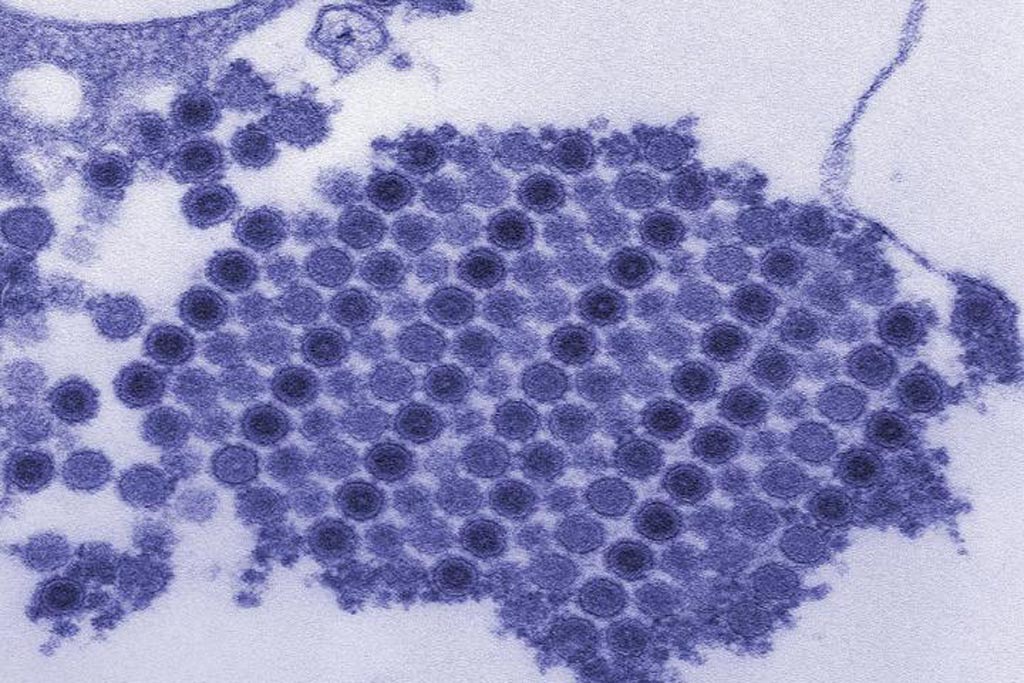CRISPR/Cas9 Screen Identifies Binding Site for Alphaviruses
By LabMedica International staff writers
Posted on 31 May 2018
A team of molecular virologists has proposed a strategy for preventing arthritis-causing viruses such as chikungunya and Ross River virus from binding and invading host cells.Posted on 31 May 2018
Arthritogenic alphaviruses comprise a group of enveloped RNA viruses that are transmitted to humans by mosquitoes and cause debilitating acute and chronic musculoskeletal disease. The host factors required for alphavirus entry have been poorly characterized.

Image: A scanning electron micrograph (SEM) of chikungunya virus particles crystallized into a neat grid (Photo courtesy of the CDC / Cynthia Goldsmith).
To correct this lack of knowledge investigators at Washington University (St. Louis, MO, USA) used a genome-wide CRISPR/Cas9-based screen to search for molecules that mediated entry of various arthritogenic alphaviruses into mammalian cells.
CRISPR/Cas9 is regarded as the cutting edge of molecular biology technology. CRISPRs (clustered regularly interspaced short palindromic repeats) are segments of prokaryotic DNA containing short repetitions of base sequences. Each repetition is followed by short segments of "spacer DNA" from previous exposures to a bacterial virus or plasmid. Since 2013, the CRISPR/Cas9 system has been used in research for gene editing (adding, disrupting, or changing the sequence of specific genes) and gene regulation. By delivering the Cas9 enzyme and appropriate guide RNAs (sgRNAs) into a cell, the organism's genome can be cut at any desired location. The conventional CRISPR/Cas9 system is composed of two parts: the Cas9 enzyme, which cleaves the DNA molecule and specific RNA guides that shepherd the Cas9 protein to the target gene on a DNA strand.
The investigators reported in the May 16, 2018, online edition of the journal Nature that results of the CRISPR/Cas9 screen revealed that the cell adhesion molecule Mxra8 was an entry mediator for multiple emerging arthritogenic alphaviruses, including chikungunya, Ross River, Mayaro, and O’nyong nyong viruses. Mxra8 bound directly to chikungunya virus particles and enhanced virus attachment and internalization into cells. Gene editing of mouse Mxra8 or human MXRA8 resulted in reduced levels of viral infection of cells and, reciprocally, overexpression of these genes resulted in increased infection.
Consistent with these findings, Mxra8–Fc fusion protein or anti-Mxra8 monoclonal antibodies blocked chikungunya virus infection in multiple cell types, including primary human synovial fibroblasts, osteoblasts, chondrocytes, and skeletal muscle cells. Mutagenesis experiments suggested that Mxra8 bound to a surface-exposed region across the A and B domains of chikungunya virus E2 protein, which have been speculated as sites of attachment. Finally, administration of the Mxra8–Fc protein or anti-Mxra8 blocking antibodies to mice reduced chikungunya and O’nyong nyong virus infection as well as associated foot swelling. Therefore, pharmacological targeting of Mxra8 could form a strategy for mitigating infection and disease by multiple arthritogenic alphaviruses.
"The name chikungunya comes from the Makonde language of Tanzania, and it means, "to walk bent over." That is how painful the arthritis can be," said senior author Dr. Michael S. Diamond, professor of medicine at Washington University. "We now know how chikungunya gets into cells, and we may have found a way to block the infection. If the virus cannot get into the cell, it is unable to replicate and cause infection and disease. Not much is known about what Mxra8 does in the human body, so we need more information before developing a drug that targets Mxra8. But we could more immediately develop a drug that targets the virus and prevent it from attaching to this protein."
Related Links:
Washington University













